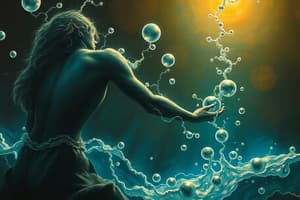Podcast
Questions and Answers
How do enzymes increase the rate of biochemical reactions?
How do enzymes increase the rate of biochemical reactions?
- By increasing the activation energy of the reaction.
- By providing an alternative reaction pathway with lower activation energy. (correct)
- By directly supplying energy to the reaction.
- By raising the temperature of the reaction environment.
Which statement accurately describes the composition of an enzyme?
Which statement accurately describes the composition of an enzyme?
- Enzymes consist of a protein component, sometimes with a non-protein cofactor. (correct)
- Enzymes are made of complex carbohydrates that provide a structural framework for catalysis.
- Enzymes are primarily made of lipids with a small portion of nucleic acids.
- Enzymes are solely composed of non-protein cofactors that catalyze reactions.
What is the significance of the 'active site' in enzyme catalysis?
What is the significance of the 'active site' in enzyme catalysis?
- It is the area on the enzyme responsible for maintaining its structural integrity.
- It is the region where the enzyme is synthesized within the cell.
- It is the specific region of the enzyme where substrates bind and undergo a chemical reaction. (correct)
- It is the part of the enzyme that regulates its activity through feedback mechanisms.
According to the collision theory, what conditions must be met for a reaction to occur?
According to the collision theory, what conditions must be met for a reaction to occur?
What is the 'lock and key hypothesis' in enzyme action?
What is the 'lock and key hypothesis' in enzyme action?
How does temperature affect enzyme activity?
How does temperature affect enzyme activity?
How does pH affect enzyme activity?
How does pH affect enzyme activity?
What happens to the rate of an enzyme-catalyzed reaction as substrate concentration increases, assuming enzyme concentration is constant?
What happens to the rate of an enzyme-catalyzed reaction as substrate concentration increases, assuming enzyme concentration is constant?
What is the effect of an inhibitor on enzyme activity?
What is the effect of an inhibitor on enzyme activity?
How does a competitive inhibitor affect enzyme activity?
How does a competitive inhibitor affect enzyme activity?
How does a non-competitive inhibitor decrease the rate of an enzyme reaction?
How does a non-competitive inhibitor decrease the rate of an enzyme reaction?
Under what conditions does uncompetitive inhibition occur?
Under what conditions does uncompetitive inhibition occur?
Why are enzymes considered efficient catalysts?
Why are enzymes considered efficient catalysts?
What dictates the high specificity of enzymes?
What dictates the high specificity of enzymes?
What is the role of cofactors in enzyme function?
What is the role of cofactors in enzyme function?
Which theory explains how enzymes lower the activation energy of a reaction?
Which theory explains how enzymes lower the activation energy of a reaction?
How does an enzyme-substrate complex contribute to a reaction?
How does an enzyme-substrate complex contribute to a reaction?
Which statement best describes the 'induced fit hypothesis'?
Which statement best describes the 'induced fit hypothesis'?
What is the effect of increasing enzyme concentration on the rate of an enzyme-catalyzed reaction, when substrate concentration is constant and not limiting?
What is the effect of increasing enzyme concentration on the rate of an enzyme-catalyzed reaction, when substrate concentration is constant and not limiting?
Amylase is an enzyme that breaks down starches. What category of enzymes does amylase belong to?
Amylase is an enzyme that breaks down starches. What category of enzymes does amylase belong to?
How does temperature affect the kinetic energy and collision rates of molecules in an enzymatic reaction?
How does temperature affect the kinetic energy and collision rates of molecules in an enzymatic reaction?
If an enzyme denatures at temperatures above its optimum, what happens at the molecular level?
If an enzyme denatures at temperatures above its optimum, what happens at the molecular level?
How does increasing substrate concentration affect the rate of an enzymatic reaction when enzyme concentration is fixed and the active sites are saturated?
How does increasing substrate concentration affect the rate of an enzymatic reaction when enzyme concentration is fixed and the active sites are saturated?
What is the primary mechanism by which competitive inhibitors affect enzyme-catalyzed reactions?
What is the primary mechanism by which competitive inhibitors affect enzyme-catalyzed reactions?
How does a non-competitive inhibitor binding to an enzyme affect substrate binding?
How does a non-competitive inhibitor binding to an enzyme affect substrate binding?
What distinguishes uncompetitive inhibition from other types of enzyme inhibition?
What distinguishes uncompetitive inhibition from other types of enzyme inhibition?
How does an enzyme typically affect the equilibrium of a reversible chemical reaction?
How does an enzyme typically affect the equilibrium of a reversible chemical reaction?
Which of the following is a direct consequence of enzymes remaining unchanged at the end of a reaction?
Which of the following is a direct consequence of enzymes remaining unchanged at the end of a reaction?
In the reaction pathway, reactant 1 + reactant 2 -> product, how does an enzyme change this pathway (Route A) to Route B?
In the reaction pathway, reactant 1 + reactant 2 -> product, how does an enzyme change this pathway (Route A) to Route B?
Which statement properly describes the difference between the activation energy of an uncatalyzed reaction vs an enzyme-catalyzed reaction?
Which statement properly describes the difference between the activation energy of an uncatalyzed reaction vs an enzyme-catalyzed reaction?
What is the role of Creatine Kinase (CK) in the body?
What is the role of Creatine Kinase (CK) in the body?
What is the function of Lipase?
What is the function of Lipase?
What is the function of Thrombin?
What is the function of Thrombin?
What role do Aspartate aminotransaminase (AST) and alanine aminotransaminase (ALT) play within the body?
What role do Aspartate aminotransaminase (AST) and alanine aminotransaminase (ALT) play within the body?
What is the role of DNA polymerase?
What is the role of DNA polymerase?
What is the role of Glucose-6-phosphate dehydrogenase?
What is the role of Glucose-6-phosphate dehydrogenase?
What is the role of Protease?
What is the role of Protease?
In enzyme kinetics, what does the term 'saturation' refer to?
In enzyme kinetics, what does the term 'saturation' refer to?
Flashcards
Enzymes
Enzymes
Efficient catalysts that speed up biochemical reactions.
Activation energy
Activation energy
Enzymes speed up reactions by lowering this energy requirement.
Enzyme specificity
Enzyme specificity
Enzymes are very selective in what they catalyze.
Proteins
Proteins
Signup and view all the flashcards
Globular proteins
Globular proteins
Signup and view all the flashcards
pH and temperature
pH and temperature
Signup and view all the flashcards
Cofactors and coenzymes
Cofactors and coenzymes
Signup and view all the flashcards
Collision
Collision
Signup and view all the flashcards
Active Site
Active Site
Signup and view all the flashcards
Substrate
Substrate
Signup and view all the flashcards
Lock and Key Hypothesis
Lock and Key Hypothesis
Signup and view all the flashcards
Induced Fit Hypothesis
Induced Fit Hypothesis
Signup and view all the flashcards
Digestive Enzyme
Digestive Enzyme
Signup and view all the flashcards
Convert sugar into energy
Convert sugar into energy
Signup and view all the flashcards
Creatine kinase (CK)
Creatine kinase (CK)
Signup and view all the flashcards
DNA Synthesis
DNA Synthesis
Signup and view all the flashcards
Glucose-6-phosphate dehydrogenase
Glucose-6-phosphate dehydrogenase
Signup and view all the flashcards
Lipase
Lipase
Signup and view all the flashcards
Protease
Protease
Signup and view all the flashcards
Thrombin
Thrombin
Signup and view all the flashcards
Optimal Temperature
Optimal Temperature
Signup and view all the flashcards
pH Range
pH Range
Signup and view all the flashcards
Higher concentration
Higher concentration
Signup and view all the flashcards
Inhibitors
Inhibitors
Signup and view all the flashcards
Competitive inhibitors
Competitive inhibitors
Signup and view all the flashcards
Non-Competitive inhibitors
Non-Competitive inhibitors
Signup and view all the flashcards
Uncompetitive Inhibition
Uncompetitive Inhibition
Signup and view all the flashcards
Study Notes
- Enzymes are efficient catalysts for biochemical reactions.
- They speed up reactions by providing an alternative pathway with lower activation energy.
- Enzymes participate in reactions but remain unchanged at the end.
- They alter reaction rates but not equilibrium positions.
- Most chemical catalysts are not selective, but enzymes are highly selective.
- Enzyme specificity is due to the shapes of enzyme molecules.
- Many enzymes consist of a protein and a non-protein (cofactor).
- Enzyme proteins are usually globular.
- Enzyme activity is sensitive to pH and temperature due to bond disruptions in protein structures.
- Cofactors can be prosthetic groups, activators (positively charged metal ions), or coenzymes (organic molecules).
- Reacting molecules must collide with correct orientation and sufficient energy to overcome activation energy.
- Enzymes provide an active site conducive to binding reacting molecules (substrates).
- Enzyme-substrate complexes form intermediates with lower activation energy routes.
- Amylase is a digestive enzyme that breaks down starches.
- Aspartate aminotransaminase (AST) and alanine aminotransaminase (ALT) help the liver convert sugar into energy.
- Creatine kinase (CK) helps muscles create energy.
- DNA polymerase facilitates growth by allowing DNA to duplicate.
- Glucose-6-phosphate dehydrogenase keeps red blood cells healthy by preventing damage to the cell.
- Lipase is a digestive enzyme that breaks down fats and oils
- Protease is a digestive enzyme that breaks down proteins.
- Thrombin causes blood to clot.
Models of Enzyme Action
- The active site is part of the molecule that has just the right shape and functional groups to bind to one of the reacting molecules.
- The substrate is the reacting molecule that binds to the enzyme.
- The Lock and Key Hypothesis says substrates fit into the enzyme's active site to form an intermediate.
- The Induced Fit Hypothesis says enzymes change shape when substrates approach, induced by substrate molecules.
Factors Affecting Catalytic Activity of Enzymes
- Optimal enzyme activity is usually around 37.5°C for human enzymes but higher temperatures increase kinetic energy and collision rates.
- Enzymes denature at temperatures above optimal as bonds break.
- Enzymes work within a narrow pH range for optimal activity.
- pH changes can make or break bonds, altering enzyme shape and effectiveness.
- The rate of enzyme catalyzed reactions depends on enzyme and substrate concentrations.
- Higher substrate concentration increases rate until active sites are saturated.
- With constant substrate concentration, reaction rate is proportional to enzyme concentration.
- Inhibitors reduce or stop enzyme activity by blocking or distorting the active site.
- Competitive inhibitors occupy the active site.
- The inhibitor (molecule) has a structural and chemical similarity to the substrate.
- Non-competitive inhibitors attach elsewhere (allosteric site) and alter enzyme shape.
- When the inhibitor binds to the allosteric site, the enzyme's active site undergoes structural shift.
- The active site and substrate no longer share affinity as a result of this alteration, preventing substrate binding.
- Uncompetitive inhibition binds only to the substrate-enzyme complex.
- Non-competitive inhibition can occur with or without the presence of the substrate, whereas uncompetitive inhibition requires the formation of an enzyme-substrate complex.
Studying That Suits You
Use AI to generate personalized quizzes and flashcards to suit your learning preferences.




